Oral presentations and abstracts
Description: Remote sensing of Solar System objects such as planetary atmospheres, comets and asteroids, or the space between them, relies largely on the analysis of the solar light scattered by dust particles and clouds. Polarization is an invaluable tool for obtaining information on the physical properties (size, shape, and composition) and location of the scattering particles in the corresponding atmosphere.
The aim of this session is to bring together observers, modelers, and experimental physicists to discuss the most recent results and advances in the characterization of dust particles by their spectro-polarimetric pattern.
Long-periodic comet C/2011 KP36 (Spacewatch), defined by Bauer et al. 2013 (Aph. J. 773:22) as a Scattered Disc Object, has a period of around 238 years and perihelion distance q=4.88 au. Its semi-major axis (a=38.41 au) is larger than aphelion distance of Neptune (aN=30.07 au). Comprehensive observations of the comet were carried out at the 6-m BTA telescope of the Special Astrophysical Observatory (Russia) with the multimode focal reducer SCORPIO-2.
Long-slit spectra in the visible and photometric and linear polarimetric images with the g-sdss and r-sdss filters were obtained on November 25, 2016, after perihelion passage, when heliocentric and geocentric distances of the comet were 5.06 au and 4.47 au, respectively. The observations were done at the phase angle 9.57 deg. Two strong jet-like structures in solar and antisolar directions and two short and narrow jet features in a direction almost perpendicular to the Sun–comet direction were revealed in the coma. The cometary activity was characterized by Afρ values of 1065±11 cm in the g-sdss filter and 1264±17 in the r-sdss filter.
The spectrum of comet C/2011 KP36(Spacewatch) we observed shows emissions from the ion CO+. It is second comet, for which we detected emissions at large heliocentric distances more 4 au.
In the near-nucleus coma, the polarization is about 5% (in absolute value), then it decreases, reaching the minimal values about 2% in the region of 10000–20000 km. The polarization increases up to 3.7–5% at the distance of 25000–45000 km, and then the degree of polarization changes with wave-like variations up to 1–4%, depending on the cut direction, with increasing distance up to ~105 km. See Figure 1 for details.
On average, the (g–r) color index of the dust varies with increasing distance from the nucleus. In the near-nucleus region, the color index is about 0.7m. At distances from about 10000 to 20000 km from the photocenter, dust color is bluer (~0.33m) in comparison with the Sun color (color indices (g–r) for the Sun is 0.44m
To characterize the dust in this comet, we modeled both polarization and color in the directions of all jets as well as for the regular coma. We considered a variety of materials typical for cometary dust and Centaurs (including porous particles) and their mixtures and modeled the dust as ensembles of rough spheroids of a variety of obliquity and size. Our modeling allowed us to reproduce not only specific values of color and polarization but also their change with the distance from the nucleus using realistic ideas about possible changes in particle size and composition as they move through the coma and also to compare the dust in different cometary features.
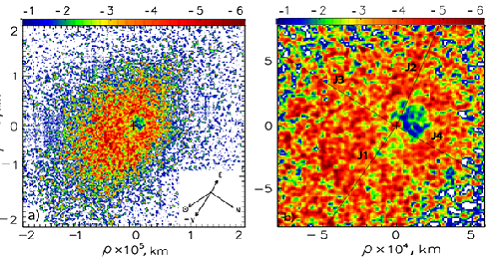
Figure 1 A spatial distribution of polarization degree in comet C/2011KP36 (Spacewatch) in the r-sdss filter obtained at the phase angle 9.6 deg. The left image shows the polarization map for the whole coma with its associated scale bar in percentage on the top of the image, while the image on the right displays the coma area around the nucleus in an enlarged scale. The location of the optocenter is marked with a black cross, and jets with black lines. The arrows point in the direction to the Sun, North (N), East (E), and negative velocity vector of the comet as seen in the observer’s plane of sky (V). Negative distance is in the solar direction.
How to cite: Ivanova, O., Kolokolova, L., Luk’yanyk, I., Kreshenok, V., Rosenbush, V., Kiselev, N., Afanasiev, V., and Kirk, Z.: Scattering properties of dust in C/2011 KP36 (Spacewatch), Europlanet Science Congress 2020, online, 21 Sep–9 Oct 2020, EPSC2020-346, https://doi.org/10.5194/epsc2020-346, 2020.
Abstract
We present detailed polarimetric analysis of pre-perihelion STEREO observations of Kreutz group comet C/2010 E6 (STEREO), focusing on the changes in polarisation with decreasing heliocentric distance in the pre-perihelion STEREO spacecraft hourly observations of the comet in March 2010. We utilise a bespoke image analysis method for the coronagraph data, finding the Stokes parameters for comet and its tail. The results show a clear variability in polarisation, which can be attributed to sublimation of refractory material.
1. Introduction
Polarimetry is a useful tool for remote observations of comet refractory material, since it can provide constraints on its structure and composition. Near-Sun comets like C/2010 E6 (STEREO) are interesting partly for their frequency – Kreutz group comets represent the single largest comet family [1] – but mostly for the intense near-Sun environment they experience. The comet’s approach to perihelion is likely accompanied by sublimation of refractory material, therefore we can, by studying comet's changing polarimetric signature during its approach to the Sun, extract information about the composition of refractory material in cometary dust. The full analysis is presented in [2].
2. Observations
Comet C/2010 E6 (STEREO) belongs to the Kreutz family of sungrazing comets, which share very similar orbital parameters and are thought to be the remnants of a larger parent comet [1,3,4].
The comet was imaged by the twin STEREO (Solar Terrestrial Relations Observatory) spacecraft in March 2010; A (Ahead) and B (Behind). In this work only COR2 visible light (bandpass 650-750 nm) coronagraph imagery is used [5].
Permanently in the light path of COR2 is a linear polariser which can be set at three angles: 0º, 120º, and 240º relative to a reference position. A sequence (triplet) of images using the three different polariser angles in quick succession is taken once per hour.
3. Methodology
The image analysis was conducted using a bespoke semi-automated routine fine-tuned for the use with STEREO COR2 data.
Firstly, the image triplets undergo standard pre-processing using the SECCHI_PREP routine from the SolarSoft library for IDL [6]. Then the comet head is found interactively in the image triplets.
Orbital parameters are used to find the plane of the comet's orbit, in which the dust tail is assumed to lie; all data points in the images are then mapped onto this plane. From this, the phase angle - between the Sun, the comet, and the spacecraft – can be determined.
Comet tail is then traced in each separate image. Its transverse cross-sections first have their background removed using a cubic fit and are then truncated (integrated) to a single point for each longitudinal step.
The three resulting polarised intensity vectors from the image triplet are then aligned, and the polarimetric properties (Stokes parameters Q, U, and I) calculated. The method is similar to, but distinct from, the one used by [7,8].
4. Results
We present two sets of plots of STEREO/SECCHI/COR2 observations of comet C/2010 E6 (STEREO): polarimetric (Figure 1) and photometric (Figure 2). All data is plotted against heliocentric distance. Since the data would contain considerable overlap otherwise, three different offsets are used to stagger the data.
The phase angle information is lost in these plots. STEREO-A phase angle observations range between ~35º and ~25º (right to left). The phase angle range in STEREO-B observations is ~135º to ~105º (right to left). The phase angle variation along the tail is small for each observation.
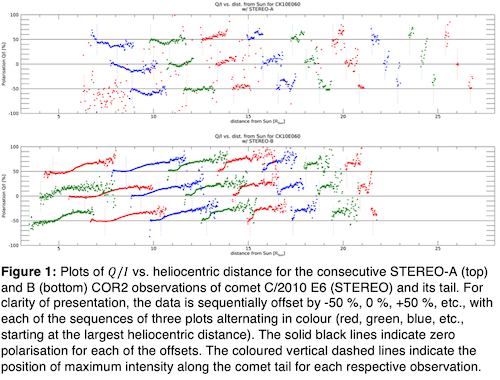
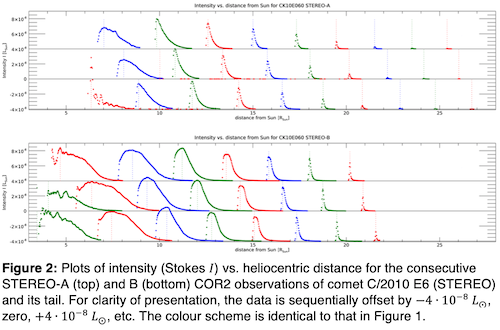
5. Discussion & Conclusions
Prior to perihelion, at which it likely disintegrated, comet C/2010 E6 (STEREO) exhibited a variety of peculiar behaviours - both photometric and polarimetric - which distinguish it from most other comet observations [9].
Most notable is the sudden drop in polarisation of the comet nucleus at ~20 R⨀, which then spread slowly along the comet tail. This is accompanied later (~15 R⨀) by a broadening of the intensity peak from the nucleus further down the tail. The broadening and brightening are consistent with those observed by e.g. [4].
The polarimetric signature of near-zero (STEREO-B, high phase angles) or negative (STEREO-A, low phase angles) polarisation spreading from the near-nucleus region along the tail is consistent with sublimation of silicate particles at local temperatures exceeding their sublimation point. This effect propagates slowly both through the ablating surface and through the dust tail, as sublimation acts as a source of cooling. Thus the observed negative polarisation at low phase angle may explained as the response of the as of yet unsublimated fluffy dust particles of primarily silicate composition.
Acknowledgements
We would like to thank M. Knight, K. Battams, and V. Andretta for their help and collaboration. This research is supported through the UK Science and Technology Facilities Council and has made use of data and/or services provided by the IAU’s Minor Planet Center.
References
[1] Battams, K. and Knight, M. M.: SOHO comets: 20 years and 3000 objects later, Phil. Trans. R. Soc. A, Vol. 375: 20160257, 2017
[2] Nežič, R. et al.: Polarimetric analysis of pre-perihelion STEREO observations of Kreutz group comet C/2010 E6 (STEREO), 2020, in prep.
[3] Jones, G. H. et al.: The Science of Sungrazers, Sunskirters, and Other Near-Sun Comets, Space Sci Rev, Vol. 214: 20, 2018
[4] Knight, M. M. et al.: Photometric Study of the Kreutz Comets Observed by SOHO from 1996 to 2005, AJ, Vol. 139: 3, pp. 926-949, 2010
[5] Howard, R. A., Moses J. D., and Socker D. G.: Sun Earth Connection Coronal and Heliospheric Investigation (SECCHI), Proceedings of SPIE, Vol. 4139-26, 2000
[6] Freeland, S. L. and Handy, B. N.: Data Analysis with the SolarSoft System, Solar Physics, Vol. 182, pp. 497-500, 1998
[7] Thompson, W. T.: Linear polarization measurements of Comet C/2011 W3 (Lovejoy) from STEREO, Icarus, Vol. 261, pp. 122-132, 2015
[8] Thompson, W. T.: Changing linear polarization properties in the dust tail of comet C/2012 S1 (ISON), Icarus, Vol. 338, pp. 113533, 2020
[9] Kiselev, N. et al.: Comets, Chapter 22 in Polarimetry of Stars and Planetary Systems (ed.: Kolokolova, L. et al.), CUP, pp. 379-404, 2015
How to cite: Nezic, R., Bagnulo, S., and Jones, G.: Effects of heliocentric distance on polarisation of comet C/2010 E6 (STEREO), Europlanet Science Congress 2020, online, 21 Sep–9 Oct 2020, EPSC2020-817, https://doi.org/10.5194/epsc2020-817, 2020.
Summary
Linear polarization observations have suggested the presence of dust particles that scatter solar light within cometary comae and the interplanetary dust cloud. Recent progresses result from in-situ observations or remote observations from large telescopes, while avoiding contamination from atmospheric airglow. The interpretation of polarimetric observations, at given phase angles and wavelengths, is a powerful tool to better understand the composition and physical properties of these irregular dust particles and their formation processes. It now provides clues to the origin of the Solar System and to some characteristics of dust in stellar systems, as discussed in [1].
Along a line-of-sight within the interplanetary dust cloud, both solar distance (R) and phase angle (a) vary, meaning that the intensity and linear polarization (P) of solar light scattered by interplanetary dust (i.e. zodiacal light) need to be inverted to retrieve some local properties. In the near-ecliptic symmetry plane of the cloud, P(a) phase curves are smooth, with a slightly negative branch below 20° and a maximum by 90°. For a constant a=90°, P increases with R, at least between 0.5 au and 1.5 au. Numerical and experimental simulations (in the laboratory and under microgravity conditions) of such results suggest i) the presence in dust of low-absorbing minerals and absorbing complex organics, with a significant amount of fluffy aggregates, ii) some sublimation of semi-volatile organics with decreasing R and increasing temperatures [2; also 3-5 for reviews].
In situ observations have, up to now, only been done on board Giotto during its flybys, allowing us to suggest the presence of a fragment in the coma of 26P/Grigg-Skjellerup and to derive very low values for geometric albedos (about 3%) and densities (50 to 500 kg m−3) of 1P/Halley dust particles [6-7].
Dust whole-coma remote observations, which avoid contamination from gaseous emissions with narrow interference filters, have been used by various teams to obtain P(a) phase curves. As for the zodiacal light, they are smooth; also P (whenever positive) increases with wavelenght for a given a. Numerical and experimental simulations are consistent with a dust population of irregular and possibly fractal structure, with complex optical indices suggesting mixtures of minerals and more absorbing organics [8-10]. Polarimetric in situ observations and remote imaging of comae (at given phase and wavelenght) suggest that the properties of dust are quite different in dust jets than elsewhere in a dust coma, and in Oort-cloud comets than in periodic comets [9, 11-12]. Such trends fairly agree with the ground-truth provided by the Rosetta rendezvous with 67P/Churyumov-Gerasimenko [13 for a review]. Finally, experimental simulations of 67P pre-perihelion brightness phase curves provide clues to an important amount of organic compounds and to fluffy aggregates with sizes above 10 micrometres [14].
Back in time, polarimetric results on cometary dust contribute to a better understanding of the formation of dust particles, in external regions of the protosolar disk. They likely resulted from submicron-sized grains accreted at low collision velocities, with further addition of minerals processed near the proto-Sun [e.g. 15-16]. At the Late Heavy Bombardment epoch, enormous influxes of interplanetary dust might then have provided a massive delivery of cometary carbonaceous compounds on telluric planets [1; 17].
Beyond in space, properties of interplanetary dust may suggest improvements in the modelling of observations of protoplanetary and debris disks. Updating results on the modelling of the dust continuum emission of the protoplanetary disk around MWC 758 [18], with moderately porous spherical particles and the above-mentioned phase functions retrieved by Rosetta, provides a better agreement between synthetic and observed maps of emission at sub-millimetre wavelengths. Besides, observations of debris disks have now shown that light scattering properties of dust in debris disks are far from those predicted by Mie theory and in favour of irregular dust particles, as pointed out essentially by phase functions analysis [19-20]. These results can greatly benefit from in situ and remote cometary observations and from advanced modelling of cometary dust, and at the same time provide examples of dust properties in other stellar systems to put our own Solar System into context [1].
Polarimetric observations of dust clouds in the Solar System provide clues to the properties of dust particles within cometary comae and the zodiacal cloud. Such results are already noticed to improve the modelling of dust in protoplanetary and debris disks, through the use of irregular porous particles properties instead of more conventional compact spherical ones.
Comet Interceptor, ESA F-Class mission to an Oort-cloud comet, to be launched in 2028, should provide a better understanding of its local polarimetric properties with EnVisS experiment. Meanwhile, remote polarimetric observations of comets might contribute to the target selection.
References
[1] Levasseur-Regourd, A.C. et al., PSS, 186, 104896, 2020.
[2] Hadamcik, E. et al., PSS, 183, 104527, 2020.
[3] Levasseur-Regourd, A.C. et al.: In Interplanetary dust, E. Grün et al. eds, Springer, 57-94, 2001.
[4] Lasue, J. et al., In Polarimetry of stars and planetary systems, L. Kolokolova et al. eds, CUP, 419-436, 2015.
[5] Lasue et al., PSS, 104973, 2020 (in press).
[6] Levasseur-Regourd et al., PSS, 41, 167-169, 1993.
[7] Fulle, M. et al., AJ, 119, 1968-1977, 2000.
[8] Lasue, J. et al., Icarus, 199, 129-144, 2009.
[9] Kiselev, N. et al., In Polarimetry of stars and planetary systems, L. Kolokolova et al. eds, CUP, 379-404, 2015.
[10] Muñoz, O. et al., ApJ, 247:19, 2020.
[11] Hadamcik, E. et al., MNRAS, 462, S507-S515, 2017.
[12] Rosenbush, V.K., et al., MNRAS, 469, S475-S491, 2017.
[13] Levasseur-Regourd, A.C. et al., Space Sci. Rev., 214:64, 2018.
[14] Levasseur-Regourd, A.C. et al., A&A, 630, A20, 2019.
[15] Fulle, M. & Blum, J., MNRAS. 469, S39-S44, 2017.
[16] Lasue, J. et al., A&A, 630, A28, 2019.
[17] Nesvorný, D., et al., ApJ, 713, 816-836, 2010.
[18] Baruteau, C., et al., MNRAS, 486, 304-319, 2019.
[19] Milli, J., et al., A&A, 599, A108, 2017.
[20] Milli, J., et al., A&A, 626, A54, 2019.
How to cite: Levasseur-Regourd, A.-C., Baruteau, C., Lasue, J., Milli, J., and Renard, J.-B.: Linear polarization as a tool to characterize interplanetary, cometary, and extrasolar dust particles , Europlanet Science Congress 2020, online, 21 Sep–9 Oct 2020, EPSC2020-391, https://doi.org/10.5194/epsc2020-391, 2020.
Context
Debris discs represent the ultimate stage of planetary formation, after the initial gas-rich protoplanetary disc dissipated and potential giant planets have already formed in the system. Infrared observations have shown that at least 20% of main-sequence stars host a dusty debris disc [1], i.e. a massive analog to the Edgeworth-Kuiper belt in the solar system, typically detected at tens to hundreds of astronomical units from their parents stars. Considering the short lifetime of the dust particles compared to the system age, this dust population is believed to originate from collisions of a population of kilometre-sized parent bodies, called planetesimals, reminiscent of Kuiper belt objects or comets in our solar system. Collisions constantly replenish the disc and create smaller and smaller dust particles, until the smallest micron-sized particles leave the system expelled by the radiation pressure of the central star.
Polarimetry as a tool to study debris discs in scattered light
Extreme adaptive optics instruments working at optical / near-infrared wavelengths have revealed exquisite details on debris discs [2,3], allowing to extract the optical properties of the dust particles such as the phase function, the degree of polarisation and the spectral reflectance. These are three powerful diagnostic tools to understand the physical properties of the dust population : the size, shape and composition of the micron-sized dust particles.
An ideal laboratory: HR4796
It is however very rare to be able to combine all those three observables for the same system, because this requires different high-contrast imaging techniques to suppress the starlight and reveal the faint scattered light emission from the dust. Due to its properties, the narrow ring detected at 77 astronomical units around the A-type star HR4796 is a notable exception, with both unpolarised and polarised images covering the optical and near-infrared wavelengths [3]. Two new studies have revealed the intriguing properties on this system. The first one [4] revisited optical polarised light images obtained earlier with SPHERE/Zimpol [5] (left figure) and proposed an original technique to retrieve with enhanced fidelity the scattering phase function of the dust in polarised light (inset of the right figure). This method more accurately accounts for projection effects that can enhance the surface brightness of a disc along the semi-major axis if the scale height of the ring is sufficiently large. The second study [5] extracted the degree of polarisation of the disc in the near-infrared from 20 to 120 degrees. Neither of those two studies can fully reconcile the degree of polarisation of the dust population, its scattering phase function and the particles blow-out size with a single scattering theory (right figure).
In this contribution, we propose to discuss the dust properties compatible with current and new observations of this disc. We will base the discussion on laboratory experiments and analogies with cometary dust particles, rather than relying on scattering theories assuming spherical dust particles. We show that this interdisciplinary approach moving away from the Mie theory enables to find interesting candidates to reconcile the optical properties and thermal behaviour of the dust particles in this system.
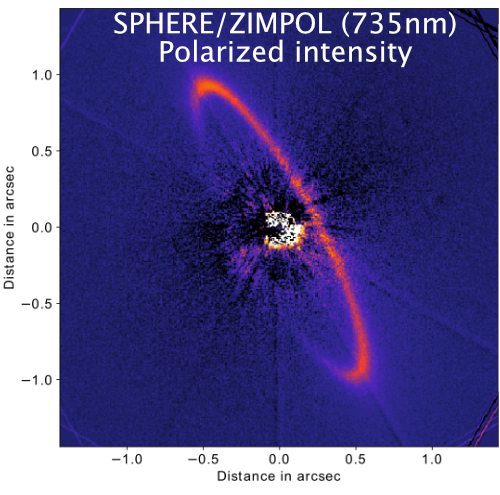
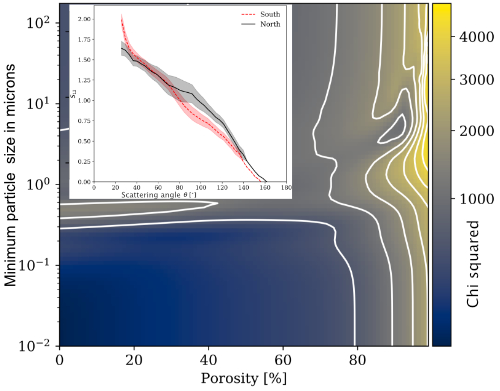
Figure: Left: VLT/SPHERE/Zimpol polarimetric observations of the HR4796 disc, in a broad (290nm-wide) optical filter centered at 735nm [5]. North is up, East to the right, the West side of the disc is the forward-scattering side. Right: Extracted polarised scattering phase function (-S12) from 20 to 160 degrees described in [4] (inset graph) and Χ2 map of a grid of models parametrised by the porosity and minimum particle size, using the Distribution of Hollow Spheres [7] suggesting sub-micronic low porosity particles.
References
[1] Hughes, A. M., Duchêne, G., & Matthews, B. C. (2018) "Debris Disks: Structure, Composition, and Variability," ARA&A, 56, 541-591 - 2018ARA&A..56..541H
[2] Esposito, T. M., Kalas, P., Fitzgerald, M. P., et al. (2020) "Debris Disk Results from the Gemini Planet Imager Exoplanet Survey's Polarimetric Imaging Campaign," AJ, 160, 24 - 2020AJ....160...24E
[3] Milli, J., Vigan, A., Mouillet, D., et al. (2017) "Near-infrared scattered light properties of the HR 4796 A dust ring. A measured scattering phase function from 13.6° to 166.6°," A&A, 599, A108 - 2017A&A...599A.108M
[4] Olofsson, J., Milli, J., Bayo, A., et al. (2020) "The challenge of measuring the phase function of debris disks. Application to HR 4796," arXiv, arXiv:2006.08595 - 2020arXiv200608595O
[5] Milli, J., Engler, N., Schmid, H. M., et al. (2019) "Optical polarised phase function of the HR 4796A dust ring," A&A, 626, A54 - 2019A&A...626A..54M
[6] Arriaga, P., Fitzgerald, M. P., Duchêne, G., et al. (2020) "Multiband Polarimetric Imaging of HR 4796A with the Gemini Planet Imager," arXiv, arXiv:2006.06818 - 2020arXiv200606818A
[7] Min, M., Hovenier, J. W., & de Koter, A. (2005) "Modeling optical properties of cosmic dust grains using a distribution of hollow spheres," A&A, 432, 909-920 - 2005A&A...432..909M
How to cite: Milli, J., Baruteau, C., Lasue, J., Levasseur-Regroud, A.-C., Renard, J.-B., and Olofsson, J.: The polarimetric dust properties of the debris disc HR4796, Europlanet Science Congress 2020, online, 21 Sep–9 Oct 2020, EPSC2020-249, https://doi.org/10.5194/epsc2020-249, 2020.
Introduction: In-situ and telescopic observations of icy moons during the last decades have improved our understanding of these bodies. One of the main features discovered is the production of pristine material at their surfaces by plumes, detected on Enceladus[1, 2] and possibly on Europa [3]. In such dynamical environment, the ice particles could be produced by flash-freezing of aqueous solutions expulsed from the subsurface [4, and references therein].
At the University of Bern, the Setup for Production of Icy Planetary Analogues (SPIPA) [5] allows us to produce flash-frozen particles by pulverization of liquid salty solutions into liquid nitrogen. The freezing of the particles is dominated by the Leidenfrost effect [6] which generates a nitrogen outgassing that makes droplets levitating above it. The first seconds of crystallization are made at low (and rapidly decreasing) temperature, inducing a complex internal structure of the particles (mixed of amorphous and crystalline phases).
The characterization of icy surfaces in total light intensity can be complemented by the analysis of the degree of linear polarization of the light scattered by atmosphereless bodies [7]. For many years, ground-based polarimetric observations have provided a consequent dataset to characterize icy surfaces [8, 9] allowing a better preparation for the upcoming space missions Europa Clipper (NASA) and JUICE (ESA).The polarized reflectance is highly sensitive to the morphology of grains (e.g. size, shape, structure) as much as the chemistry (e.g. composition and mixture) [10]. The evolution of polarimetric properties of salty ice particles during warming-up, accompanied with the transition of the amorphous fraction into crystalline, gives insights on the morphology (mostly internal, but also external) of the grains, for the considered salt. Therefore, we have measured the evolution of the degree of linear polarization (Q/I) of salty ices with temperature raising until the eutectic point of the solutions (NaCl, MgCl2, Na2SO4 and MgSO4).
POLICES setup: The POLarimeter for ICE Samples has been developed at the University of Bern to measure, among others, the degree of linear polarization of icy samples [10] and its dependence to phase angle. The experiment is a goniometer with a fixed emergence angle. The incidence angle is defined by the position of the light source, fixed at the end of a rotating motorized arm. Light is either produced by LEDs at three different wavelengths (530, 625 and 810 nm), or in another configuration with a monochromator to select narrow spectral bandpasses. In both cases, depolarizers are used to ensure an unpolarized incident light.
To permit repeatable measurements of icy samples, a hermetic box, painted in black to mitigate stray light, has been added to the setup in order to control the relative humidity and prevent frost formation (Fig. 1A). As depicted in Fig. 1B, polarimetric phase curves can be measured with a phase angle ranging from 1.5° to 73° inside the box [10].
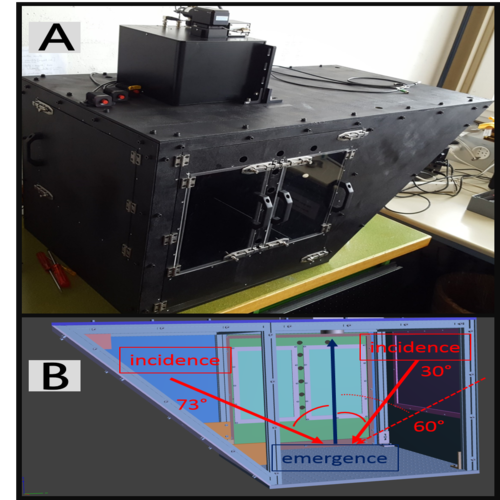
Figure 1: (A) POLarimeter for ICE Samples (POLICES). (B) 3D Back view with geometry of observation
Sample preparation and measurements: The degree of linear polarization is maximum at 90° of phase angle [7]. This configuration is not reachable with our setup; 60° phase angle is a good compromise to record the evolution of linear polarization. We prepared salty ices made of spherical grains 67±31 µm large [5] from saturated aqueous solutions (30wt% of NaCl, 30wt% of MgSO4) and less concentrated solutions, with MgCl2 and Na2SO4.
The ice was placed inside POLICES on a copper plate precooled with liquid nitrogen. The Stokes coefficientswere continuously measured during the slow warming-up of the sample. A Pt-100 sensor inside the ice sample continuously measured the temperature of the ice.
Figure 2 shows the evolution of the Q/I values of the ices with increasing temperature. The evolution observed for a given salt seem to be rather independent on the studied wavelengths so far, with only small offsets of the Q/I values. The pristine material is, as far as understood for now, a mixture of amorphous phase of water and salt, as much as a partially crystallized water ice, in hexagonal and potentially cubic phase [11]. The evolution with temperature corresponds to the reorganization of the sample, leading to a higher degree of crystallinity of both the ice and the salts.
The first steps of growth of these crystals (water ice and hydrated phases of salts) could be responsible for a minute fraction of Rayleigh scattering, associated to particles that are small compared to the wavelength. This mechanism is suspected to be responsible for the peaks of polarization at 175 K for the MgSO4 and centered around 195 K for NaCl (Fig. 2).
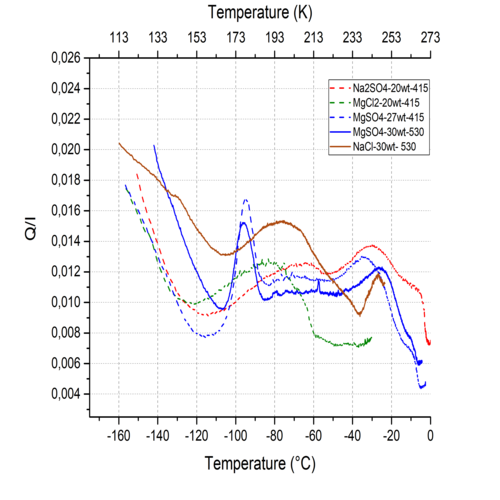
Figure 2 : Evolution of the degree of linear polarisation of salty ices. Here, for clarity, only MgSO4 is shown at 530 and 415 nm.
Summary and perspectives: The new series of measurements proposed in this work will complete the analyses of such brines in total light intensity. We intend to pursue this work with different amount of salts inside the initial brines, as well as other chemical components relevant for icy moons. In addition to measurements at a fixed phase angle, phase curves will be measured. Once validated, polarisation data will be distributed through the DACE and SSHADE platforms (https://dace.unige.ch/lossySearch/; https://www.sshade.eu/db/bypass).
Acknowledgments: The team from the University of Bern is supported by the Swiss National National Science Foundation, in part through the NCCR PlanetS.
References:
[1] Nimmo, F., et al., (2007), Nature 447. [2] Postberg, F., et al., (2009), Nature 459. [3] Roth, L., et al, (2014), Science 343. [4] F. Nimmo, F., et al., (2014), in Encyc. Solar System, Elsevier. [5] Pommerol, A., et al., (2019), Space Sci Rev 215. [6] Feng, H., et al., (2018) International Journal of Heat and Mass Transfer 127. [7] Kolokolova, L., et al., (2015), Cambridge University Press. [8] Kiselev, N., et al., (2009), Journal of Quantitative Spectroscopy and Radiative Transfer, 110. [9] Rosenbush, V., et al., (2015), Polarimetry of Stars and Planetary Systems, 340. [10] Poch, O., et al., (2018), Journal of Geophysical Research: Planets, 123. [11] Uchida, T., et al, (2010), Phys. Chem. Chem. Phys., 12.
How to cite: Cerubini, R., Pommerol, A., Poch, O., Kipfer, K., and Nicolas, T.: Polarized reflectance of salty flash-frozen ice particles, Europlanet Science Congress 2020, online, 21 Sep–9 Oct 2020, EPSC2020-580, https://doi.org/10.5194/epsc2020-580, 2020.
Abstract. The optical properties of a sample are important in, e.g., astrophysics and space science. The samples can be unique or available in limited quantities, implying that sample preservation is important. Established single-particle light-scattering measurements involve attaching the sample to a holder or measuring a laminar flow of particles, neither of which allows for a controlled and non-destructive measurement. Acoustic levitation is a state-of-the-art approach applicable to scattering measurements. We present an instrument capable of performing a full 4π scattering measurement, i.e., a measurement from any direction on the full 4π solid angle. We measure scattering properties of millimeter-sized samples at any direction. This is enabled by introducing a novel non-contacting sample holder based on acoustic levitation, which allows a disturbance-free measurement of an orientation-controlled sample. The instrument is scalable and currently employs polarized visible light (400–700 nm). It also measures beam and sample stability as well as temperature and humidity, to ensure consistency of measurements. We demonstrate a measurement of a sample consisting of agglomerated 500-nm silica spheres. The upper left 2×2 submatrix of the Mueller scattering matrix is measured from the sample along the scattering angle.
1. Introduction
Experimental measurements of light scattering by a small-particle sample in a controlled position and orientation (six degrees of freedom) has remained open. Scattering characteristics for single particles have been earlier measured as ensemble averages over the size, shape, and orientation distribution (e.g., [1]) by introducing a particle flow through the measurement volume. Scattering characteristics for single particles in levitation have been carried out using, for example, electrodynamic levitation [2] and optical tweezers [3-5]. In the present manuscript, a novel experimental method based on ultrasonic levitation with full control of the sample position and orientation is offered [6-8].
2. Levitator-scatterometer: results and discussion
Figure 1 shows our levitator scatterometer with detailed information about its components.
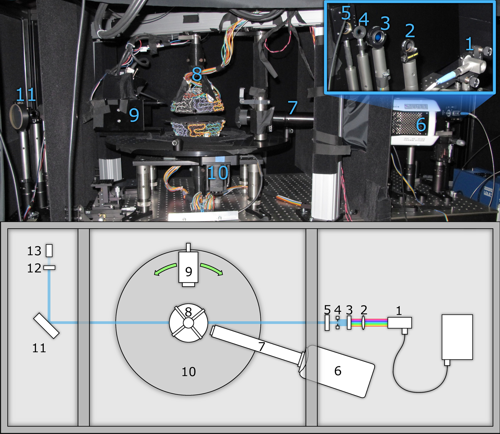
Figure 1: Levitator-scatterometer with a photograph (above) and top view schematic (below). The components are as follows: (1) fiber-coupled light source with collimator, (2) focusing lens (optional), (3) bandpass filter for wavelength selection, (4) adjustable aperture for beam shaping, (5) motorized linear polarizer, (6) high-speed camera, (7) high-magnification objective, (8) acoustic levitator for sample trapping, (9) measurement head, comprising an IR filter, motorized shutter, motorized linear polarizer, and a photomultiplier tube (PMT), (10) motorized rotation stage for adjusting measurement head angle, (11) optical flat for Fresnel reflection, (12) neutral density filter, and (13) reference PMT, for monitoring beam intensity. The system is divided into three enclosed compartments to eliminate stray light.
For the experiment, an aggregate consisting of densely-packed, nominally 0.5-µm diameter spherical SiO2 particles was selected and polished further, to approximate a spherical shape, after which it was characterized by weighing and measuring its dimensions (Fig. 2). The nearly spherical aggregate had a diameter of 1.16 mm and a volume density of 0.47. The light beam was filtered to 488±5 nm, with a Gaussian spectrum. The measured phase function, degree of linear polarization for unpolarized incident light, as well as the depolarization are shown in Figs. 3-5, respectively, as a function of the phase angle (source-sample-detector angle).
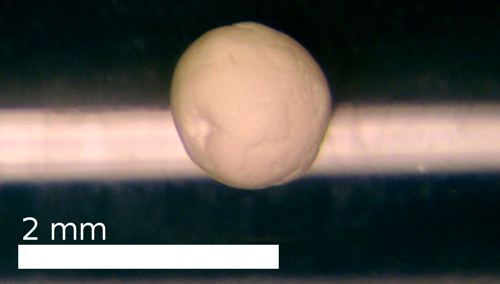
Figure 2: The sample of densely-packed spherical SiO2 grains.
Figure 3: The measured and modeled phase functions normalized to unity when integrated from 15.1° to 165.04°.
Figure 4: Degree of linear polarization for unpolarized incident light (Mueller scattering-matrix-element ratio -M12/M11 in %) from the measuements and modeling.
Figure 5: Depolarization (M22/M11) from the measurements and modeling.
Figures 3-5 further include the first modeling based on the R2T2 and SIRIS4 software (Radiative Transfer with Reciprocal Transactions; see [6] and references therein). The phase function is accurately modeled, whereas there are challenges remaining for modeling the degree of polarization and depolarization. There is compelling need for high-precision validation samples with accurate documentation: the size and shape distributions of the silica samples remain too uncertain to be utilized in model validation.
Conclusion
We have described novel experimental instrumentation for measuring light scattering by isolated samples in levitation. As it is extremely difficult to accurately characterize random media composed of sub-wavelength-scale particles or inhomogeneities, controlled Mueller-matrix measurements can offer a tool for retrieving information on the volume density and particle size and shape distribution in the medium.
Acknowledgments. Research by KM, AP, HH, and MG supported, in part, by the Academy of Finland (grants 325805 and 325806).
References
[1] Muñoz, O., Volten, H., de Haan, J. F., Vassen, W., and Hovenier, J. W.: Experimental determination of scattering matrices of olivine and Allende meteorite particles, Astron. Astrophys., Vol. 360, pp. 777–788, 2000.
[2] Sasse, C., Muinonen, K., Piironen, J., and Dröse, G.: Albedo measurements on single particles, J. Quantitat. Spectrosc. Radiat. Transf., Vol. 55, pp. 673—681, 1996.
[3] Gong, Z., Pan, Y.-L., Videen, G., and Wang, C.: Optical trapping and manipulation of single particles in air: Principles, technical details, and applications, J. Quantitat. Spectrosc. Radiat. Transf., Vol. 214, pp. 94–119, 2018.
[4] Nieminen, T. A., du Preez-Wilkinson, N., Stilgoe, A. B., Loke, V. L. Y., Bui, A. A. M., and Rubinsztein-Dunlop, H. Optical tweezers: Theory and modelling. J. Quantitat. Spectrosc. Radiat. Transf., Vol. 146, pp. 59–80, 2014.
[5] Herranen, J., Markkanen, J., and Muinonen, K. Dynamics of interstellar dust particles in electromagnetic radiation fields: A numerical solution. Radio Sci., Vol. 52(8), pp. 1016–1029, 2017.
[6] Muinonen, K., Väisänen, T., Martikainen, J., Markkanen, J., Penttilä, A., Gritsevich, M., Peltoniemi, J., Blum, J., Herranen, J., Videen, G., Maconi, G., Helander, P., Salmi, A., Kassamakov, I., and Haeggström, E.: Scattering and absorption of light in planetary regoliths. J. Visual. Exper., Vol. 149, e59607, doi:10.3791/59607, 2019.
[7] Maconi, G., Helander, P., Gritsevich, M., Salmi, A., Penttilä, A., Kassamakov, I., Haeggström, E., and Muinonen, K.: 4π scatterometer, J. Quantitat. Spectrosc. Radiat. Transf., Vol. 246, 106910, 1-7, 2020.
[8] Helander, P., Puranen, T., Meriläinen, A., Maconi, G., Penttilä, A., Gritsevich, M., Kassamakov, I., Salmi, A., Muinonen, K., and Haeggström, E.: Omnidirectional microscopy by ultrasonic sample control, Appl. Phys. Lett., Vol. 116, 194101, 1-5, 2020.
How to cite: Muinonen, K., Penttilä, A., Maconi, G., Helander, P., Hietala, H., Kassamakov, I., Gritsevich, M., Salmi, A., Nolvi, A., and Haeggström, E.: Scatterometer-levitator for light-scattering measurements with full control on particle position and orientation, Europlanet Science Congress 2020, online, 21 Sep–9 Oct 2020, EPSC2020-682, https://doi.org/10.5194/epsc2020-682, 2020.
Abstract
We present the experimental curves of phase function and linear polarization degree of five samples of olivine with di different size distributions.
These unique measurements allow for the first time to disentangle experimentally the effect of the particle size on the scattering matrix
elements. The high level of accuracy is given by the very narrow and monomodal size distributions that allow individuating the interval of size
responsible for a peculiar feature of the curves.
Introduction
Dust is a primary constituent of planetary systems and a key element to study the physical and chemical conditions involved in the formation and evolution of planetesimals in the protoplanetary disk. The investigation of the scattering of light by particles of various properties in a controlled environment, such as the laboratory, is of fundamental importance to interpret the observational data. The measurement presented in this work has been taken at the IAA Cosmic Dust Laboratory (CODULAB) [4]. The facility is devoted to the measurement of the scattering matrix of a randomly oriented cloud of particles. The angular distribution of the scattered intensity by the dust and their degree of linear polarization are intimately related to the nature of those particles. Since each material has its own characteristic features, the scattering theory can be used to interpret observations
and retrieve information about the dust properties. Therefore, the laboratory data are used as a reference for comparison and interpretation,
allowing a correct analysis of the observational data. The measurements performed in this work clearly illustrate the effect of the size of the particles
on the scattering matrix elements.
Sample characterization
The material selected for the samples is magnesium-rich olivine with a 5-10 % of iron. The two principal phases detected by X-rays diffraction
are (Mg,Fe)2SiO4 and Ca(Al,Si)Ox. Olivine is a material that has been found in comets, asteroids and IDPs [1]. The particulate of all the samples is characterized by irregular shapes and sharp edges. The decantation and centrifugation processes, using wet media assure to clean the particles from smaller components, leading to a very smooth surface. Figure 1 shows the size distributions of the 5 samples. All the size distributions of the samples are very narrow and monomodal, therefore they can be characterized by the effective radius reff , the effective variance σeff and the size parameter computed from the effective radius xeff = 2πreff/λ (see Table). The scattering properties of the particles can be described according to their
belonging to one of the following three regimes: Rayleigh (xeff << 1), resonance (xeff = 1) and geometric optics (xeff >> 1). In this work we have examples of the three regimes
| Sample | reff | σeff | xeff |
| Oli XL | 47 | 0.35 | 575 |
| Oli L | 3.5 | 0.54 | 43 |
| Oli M | 2.6 | 0.74 | 32 |
| Oli S | 1.4 | 1.0 | 17 |
| Oli XS | 0.11 | 0.38 | 1.3 |
Measurements
We measured the phase function and the degree of linear polarization of the 5 samples. The measurements were performed at wavelength λ = 514 nm, at phase angle ranging between α = 3° and α = 175°. This is the first time in which it is possible to measure the effect of the size variation
of the samples on the scattering matrix elements with such an accurate level of precision. Figure 2 shows the phase functions F11 of all the samples, normalised at α = 90°. Overall, the curves have a rather plane trend and a strong increase in the forward direction. We observe that, as long as the size of the particles increases, the curves become flatter. Furthermore, we observe a degree of backscattering enhancement, which increases when the particle size decreases, resulting more evident for the small samples. Figure 3 shows the curves of the linear polarization. They have the characteristic bell shape for irregular particles with a negative branch at small phase angles and a peak at side angles. The main effects of the size on the linear polarization curves are the variation of the maximum of polarization and the appearance of a negative branch at small phase angles. The Pmax increases with the particle size moving from the resonance regimes to the Rayleigh domain. The best-defined and clear negative branch belongs to the sample Oli S, which is composed by particles of size around 1 micron, and reaches the deepest value of Pmin. Therefore, it seems that the negative branch of polarization arises in correspondence to the presence of micrometer particles. The effect of micrometer particles has also been investigated by J. Escobar-Cerezo et al. (2018) [2], who found that removing the micrometer size particles from the sample the negative branch disappeared. Other experimental measurements of micrometer particles of different composition, such as clay, meteorites and olivine show the presence of an evident negative branch [3,4,5].
References
[1] P. Ehrenfreund et al., 2004.
[2] J. Escobar-Cerezo et al., 2018.
[3] E. Frattin et al., 2019.
[4] O. Muñoz et al., 2010.
[5] O. Muñoz et al., 2011.
How to cite: Frattin, E., Jardiel, T., Muñoz, O., Gomez-Martin, J.-C., Moreno, F., and Caballero, A.: Experimental scattering matrix of olivine: the effect of the particles size, Europlanet Science Congress 2020, online, 21 Sep–9 Oct 2020, EPSC2020-876, https://doi.org/10.5194/epsc2020-876, 2020.
Please decide on your access
Please use the buttons below to download the presentation materials or to visit the external website where the presentation is linked. Regarding the external link, please note that Copernicus Meetings cannot accept any liability for the content and the website you will visit.
Forward to presentation link
You are going to open an external link to the presentation as indicated by the authors. Copernicus Meetings cannot accept any liability for the content and the website you will visit.
We are sorry, but presentations are only available for users who registered for the conference. Thank you.

